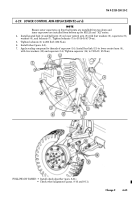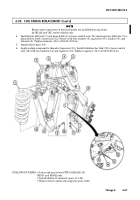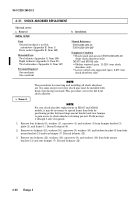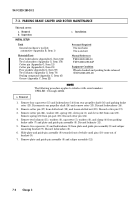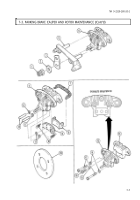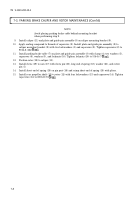TM-9-2320-280-20-2 - Page 706 of 951
This task covers:
Brake Adjustment
INITIAL SETUP:
Tools
General mechanic’s tool kit:
automotive (Appendix B, Item 1)
Materials/Parts
Cotter pin (Appendix G, Item 12)
Cotter pin (Appendix G, Item 21)
Personnel Required
One mechanic
One assistant
Manual References
TM 9-2320-280-10
TM 9-2320-280-24P
Equipment Condition
Wheels chocked and parking brake released
(TM 9-2320-280-10).
TM 9-2320-280-20-2
7-2
Change 3
7-2. PARKING BRAKE ADJUSTMENT
NOTE
The following procedure applies to vehicles with serial numbers
USBL Eff. 1 through 44824.
1.
Remove clip (5) and open boot (6) to allow access to clevis pin (7). Remove cotter pin (4), washer (9),
and clevis pin (7) securing clevis (8) to bellcrank (1). Discard cotter pin (4).
2.
Remove cotter pin (13) from slotted nut (14). Discard cotter pin (13).
NOTE
Total gauge thickness should not exceed 0.020 in. (0.508 mm).
3.
Place 0.020 in. (0.508 mm) thickness gauge between rotor (12) and brake pad (11).
4.
Adjust slotted nut (14) until thickness gauge is snug, and cam (10) is at 11 o’clock position. Install
cotter pin (13) in slotted nut (14).
5.
Repeatedly apply and adjust parking brake lever until bellcrank (1) linear travel is 0.75 in. (19 mm).
NOTE
Ensure slack is removed from parking brake linkage.
6.
Release parking brake lever and adjust clevis (8) so clevis pin (7) slides easily into bellcrank (1) and
secure with washer (9) and cotter pin (4). If alignment cannot be made at clevis (8), adjust rod (3) in
or out of rear clevis (2) to obtain proper alignment.
7.
Remove thickness gauge.
8.
Close boot (6) and secure with clip (5).
CAUTION
Apply parking brake lever gradually, while burnishing brakes, to
bring vehicle to a gradual stop. Sudden or quick application of
brake lever can damage parking brake rotor.
NOTE
Perform steps 9-11 only if parking brake pads were replaced.
9.
Burnish parking brake pads (11) by operating vehicle at 10 mph (16 kph) and, using the parking
brake, slow down and bring the vehicle to a gradual stop. Allow parking brake rotor (12) to cool by
operating vehicle 2.5 miles (4 km) at 20 mph (32 kph). Repeat this step ten times.
10.
Remove parking brake rotor (12) (para. 7-3.a) and inspect brake pads (11) for a large contact
pattern across the surface of the brake pads (11). If contact pattern is not a minimum of 90%,
install parking brake rotor (12) (para. 7-3.c) and repeat step 9. If contact pattern is satisfactory,
install parking brake rotor (para. 7-3.c) and go to step 11.
11.
Readjust, following steps 1 through 8.
Brake Adjustment
Back to Top


